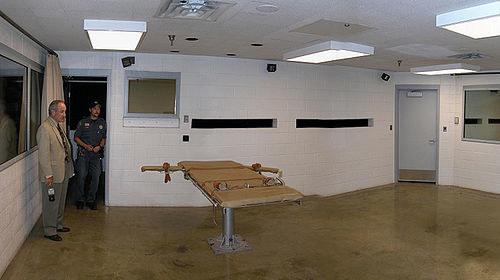
We still don't know where the drugs came from.
We know they used midazolam and hydromorphone. We know the combination was experimental. And now we know that instead of working, the drugs took nearly two hours to kill Joseph Wood, as he snorted and gasped for air 660 times.
Within a couple hours of Mr. Wood's death, the state of Arizona started damage control. Last night, Governor Jan Brewer called for an investigation into why the execution had taken so long, but she also released a statement saying: "by eyewitness and medical accounts he did not suffer."
That's not what the reporters who were in the room have written. "It was very disturbing to watch... liked a fish on shore gulping for air," Troy Hayden told The Arizona Republic.
One hour and 57 minutes is horrifically long, even when compared to the recent botched execution of Clayton Lockett, who writhed in pain for 45 minutes while the state of Oklahoma struggled to kill him in May.
It's time to ask the question: How is it possible that, in 2014, state after state is utterly failing at lethal injection? How can it be, given modern medicine, that it could take hours instead of minutes for states to kill someone?
The answer is that the death penalty simply has no place in this country. As method after method of state-sponsored killing has been deemed barbaric and archaic, states are left scrambling to invent new ways to execute.
Lethal injection started as a seemingly more humane alternative to the gas chamber, the electric chair, and firing squads. But as companies both in the U.S. and in Europe have refused to let the drugs they produce be used in executions, lethal injection has become what is essentially medical experimentation, with novel drugs and doses leading to botched execution after botched execution.
Lethal injection is not modern medicine. Executioners do not have proper training, leading to some prisoners being conscious but paralyzed as they slowly asphyxiate. States are fumbling to find drugs, concocting different combinations every time. In the case of Mr. Wood's execution, the state used a two-drug combination that had been used only once before, when the state of Ohio took 25 minutes to kill Dennis McGuire.
And these killing experiments are being carried out in secrecy. The hours before Mr. Woods was strapped to the gurney were a frenzied attempt to figure out where the drugs came from before they could be shot into his vein. We still don't know.
The greater problem underlying the horrific executions we have recently seen is not lethal injection or a matter of simply getting the drugs right. The execution of the innocent, the shameful role of race, mentally ill defendants, poor defense lawyering, and prosecutors who hide the truth – these are the problems that make the death penalty completely inappropriate in the modern world. Yet we continue to slowly pick off killing methods that are simply too barbaric to condone, but the truth is that there is no way for states – for our government – to kill someone that is in line with the type of country we want to be.
Today, my heart is with Jeanne Brown and all of those who loved Debra Dietz. My thoughts are with the executioners who will have to live with the horrific botch they carried out yesterday. This entire story is a tragic one, and it should push us to admit that the path to justice simply cannot include more gruesome violence.
It's time for a nationwide moratorium on the death penalty.
Learn more about the death penalty and other civil liberty issues: Sign up for breaking news alerts, follow us on Twitter, and like us on Facebook.




